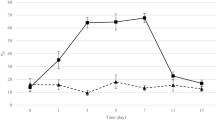Abstract
The suppression of alimentary canal flora by the three quinolones nalidixic acid, ciprofloxacin and pefloxacin was investigated in fifteen volunteers. They received the three quinolone compounds in tablet form both uncoated and colon-coated.Escherichia coli suppression was poor under nalidixic acid, but complete under ciprofloxacin and pefloxacin for both administration forms. The indigenous anaerobic flora contributing to the control of aerobicStreptococcus faecalis andCandida albicans in the intestines ('colonization resistance') was not affected by nalidixic acid and pefloxacin, and only slightly by ciprofloxacin. Out of the three quinolone compounds, only colon-coated pefloxacin was associated with a considerable absorption rate at colonie level. Using these criteria of successfulEscherichia coli clearing from the intestinal canal - left the indigenous flora more or less intact (in a 'selective' way) - and a good absorption rate, pefloxacin is found to be superior to ciprofloxacin and nalidixic acid. These results suggest that a colon-coated tablet with a low dose of pefloxacin is a promising administration form in the therapy of recurrent urinary tract infections and diarrhoeal diseases and in the prevention of gut colonization in immunocompromised hosts.
Similar content being viewed by others
References
Van der Waay D, Berghuis-de Vries HM, Lekkerkerk-van der Wees JEC. Colonization resistance of the digestive tract in conventional and antibiotic-treated mice. J Hyg (Camb) 1971;69:405-n.
Van Saene HKF, Stoutenbeek ChP, Miranda DR, Zandstra DF. A novel approach to infection control in the intensive care unit. Acta Anaesthesiol Belg 1983;34:193–208.
Shannon KP, Phillips I. The antimicrobial spectrum of the quinolones. Res Clin Forums 1985;7:29–36.
Fass RJ. The quinolones. Ann Intern Med 1985;102:400–2.
Klinge E, Männisto PT, Mäntylä J, Hänninen U. Single- and multiple-dose pharmacokinetics of pipemidic acid in normal human volunteers. Antimicrob Agents Chemother 1984;26:69–73.
Kucers A, Bennet NMcK. The use of antibiotics. London: William Heinemann, 1979:734.
Monteay G, Goueffon Y, Roquet F. Absorption, distribution, metabolic fate and elimination of pefloxacin mesylate in mice, rats, dogs, monkeys and humans. Antimicrob Agents Chemother 1984;25:463–72.
Brumfitt W, Franklin I, Grady D, Hamilton-Miller JMT, Iliffe A. Changes in the pharmacokinetics of ciprofloxacin and faecal flora during administration of a seven day course to human volunteers. Antimicrob Agents Chemother 1984;26:757–61.
Wade JC, De Jongh CA, Newman KA, Crowley J, Wiernik PH, Schimpff SC. Selective antimicrobial modulation as prophylaxis against infection during granulocytopenia: trimethoprim-sulfamethoxazole vs. nalidixic acid. J Infect Dis 1983;147:624–34.
Sleijfer DTh, Mulder NH, De Vries-Hospers HG, et al. Infection prevention in granulocytopenic patients by selective decontamination of the digestive tract. Eur J Cancer 1980;16:859–69.
Stamey TA, Timothy M, Miller M, Mihara G. Recurrent urinary infections in adult women. The role of enterobacteria. Calif Med 1971;115:1–19.
Preitsakis JK, Thompson L, Harding GKM, Marrie TJ, Hoban S, Ronald AR. A comparison of the efficacy of nalidixic acid and cefalexin in bacteriuric women and their effect on faecal and periuretral carriage of Enterobacteriaceae. J Infect Dis 1981;143:603–8.
Ronald AR, Harding GKM, Mathias R, Wong CK, Muir P. Prophylaxis of recurring urinary tract infection in females: a comparison of nitrofurantoin with trimethoprim-sulfamethoxazole. Can Med Assoc J 1975;112S:13–6.
Hoshimoto J, Akao M, Amano F. Fundamental and clinical study of AT 2266 in intestinal tract infection. Chemotherapy 1984;32(S3):630–1.
Schimpff SC, Young UM, Greene WH, Vermeulen GD, Moody MR, Wiernik PH. Origin of infection in acute non-lymphocytic leukemia. Ann Intern Med 1972;77:707–14.
Rozenberg-Arska M, Dekker AW, Verhoef J. Ciprofloxacin for selective decontamination of the alimentary tract in patients with acute leukemia during remission induction treatment: the effect on fecal flora. J Infect Dis 1985;152:104–7.
Author information
Authors and Affiliations
Rights and permissions
About this article
Cite this article
Van Saene, J.J.M., Van Saene, H.K.F., Geitz, J.N. et al. Quinolones and colonization resistance in human volunteers. Pharmaceutisch Weekblad Scientific Edition 8, 67–71 (1986). https://doi.org/10.1007/BF01975484
Received:
Accepted:
Issue Date:
DOI: https://doi.org/10.1007/BF01975484




